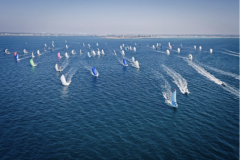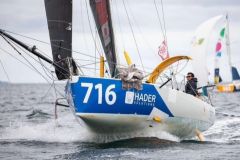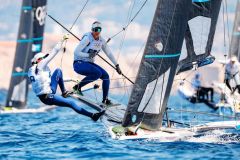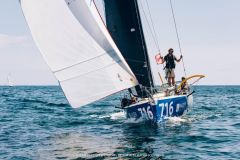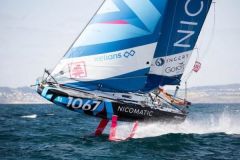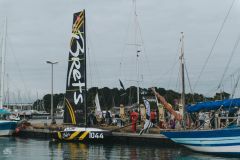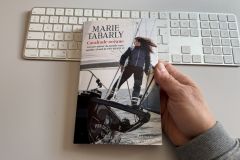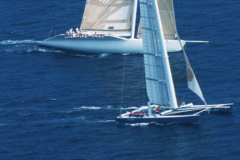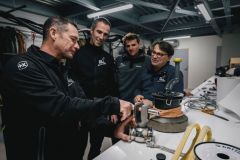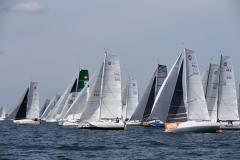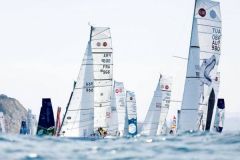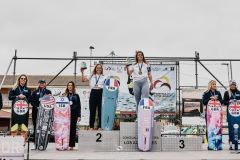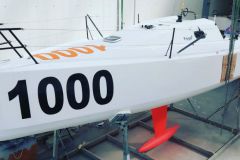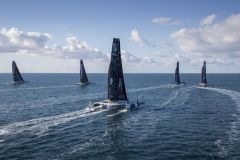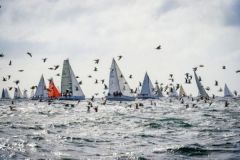You could say you have the most innovative boat of all the competitors. Can we take a look at the innovations you've tested on this boat?
There is mainly the thick sail, foils and the round bow. Even if on this hull drawing, we are the 3 e and today there's a 4 e put in the water after us. Where there was the least innovative risk was on the bow. I also have a forestay shifting system. On the deck fittings, we played a lot with the constrictors [textile blockers].
Finally there is the construction with Helium resin. This is the first recyclable boat to cross the Atlantic. It was Arkema's main innovation. We only built this new boat to validate this new resin. It was the only imperative condition of the project. If we couldn't make a part with this resin, we wouldn't leave.
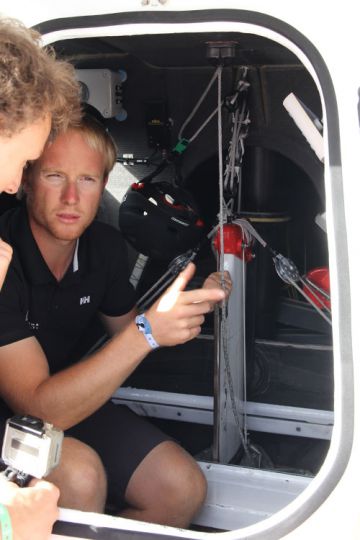
What are the first results of all these innovations? Is it working?
We did a lot of short construction periods to make it reliable. But on the whole, we're sticking to the same philosophy as at the start. We had to work on the foil settings to make it work easily. We also worked on the keel plate.
Then it's a lot of little things on the boat that make the boat reliable now, that make manoeuvring easier. We worked on the friction to remove a lot of it. Simplify the whole thing a bit, like the rudder up. Today it works.
Lately we've been working a lot on the sail and doing some things that our competitors haven't had time to see. The boat should be more powerful and less penalised in light airs.
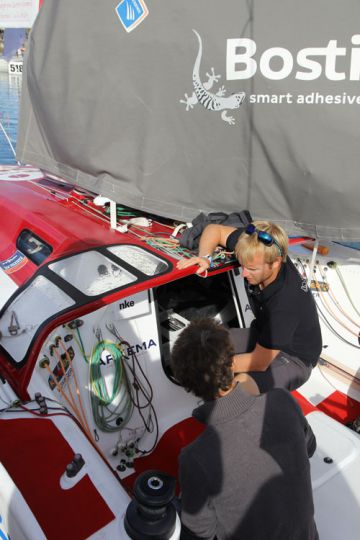
Today you are satisfied and everything will hold up to the other side?
Yes, we tried to develop as long as possible. But after a while we said to ourselves: "Now we stop developing and make the systems reliable". Today the boat is not at 100% of her potential, she will only be at 100% in 2 or 3 years time, but she is a real forerunner. She is 100% reliable and barring any unpleasant surprises, we hope to make it to the end. It's always a bit of an unknown when you set off in a Mini and even when you set off on any type of boat, the open sea remains a bit random.
Does the foil have a dynamic setting?
No, it is not dynamic [Trim is not controlled by the boat's trim]. And that's kind of the problem! On our project, I can adjust the foil, but at low speed. It's a first adjustment, but once it's launched, when the boat starts to take off, you should be able to play on the rake and I can't yet. This setting depends on the sea and the wind and it should be possible to adjust it while sailing. Between upwind and downwind, we don't have the same setting. Upwind we try to erase the foil as much as possible so that it doesn't drag water. When sailing downwind, the foil has to take the load off the hull.

What is the difference between your foils and those of Seair?
[Seair is an ex-Mini Proto 747 and only other Mini with foils that don't fit the Mini gauge]
These are two completely different projects. Our main objective was to arrive on the other side of the Atlantic. They were to prove that they could fly a boat. We've completely adapted the boat to the Mini class whereas the 747 is not, at least for the moment. It's not the same budget either. At the beginning it was the same budget except they were just to add a foil on a boat, we were to make a boat from scratch and fly it across. They have bigger foils so they fly faster. We, with our foil shape, we don't go looking for flight all the time. Our foils are more versatile.
You should also know that our architect Romaric [Neyhousser] designed these foils before the Vendée Globe. We can compare it to the first generation of IMOCA foils. If we had launched the boat a year later, we would have been on the 3 e foil generation. Together with the IMOCAs, we were the first to clear the ground. We would have liked to make them evolve, modify the shape of the tip so that they would be profitable a little earlier. But we couldn't because of a lack of time and budget, so we had to concentrate on something else. But I'm going to be the first one to cross the Atlantic with foils that protrude beyond the width. If I make it to the end, I'll be super happy.
Your goal is to get across?
The main objective is really to get to the other side, then if I have the conditions to accelerate, to pass the turbo, I won't mind. The really favourable conditions would be at least 17 knots of wind between 80-120°. If I have a tack like that for 24 or 48 hours, I think it's going to make a difference.
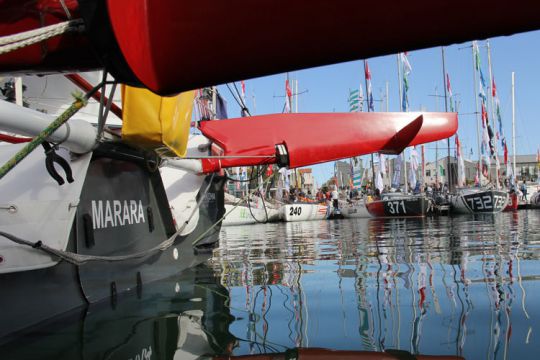
Is this a possible weather situation on the Mini-Transat?
We're going to go upwind for 24 or 30 hours and then there's going to be a small transition zone that won't last long. Very quickly, we'll be sailing downwind. These are conditions where I don't think I'll be faster than the others, but not much less. So I think that on the first stage it's not going to be a big deal. It's especially at the end of the leg where there will be a zone of light wind. It's likely to come back from behind. With the weather information we've got on board, the end of the leg is likely to be complicated and fairly random. We'll see, there may be some good surprises. I'm not going to give up anything!
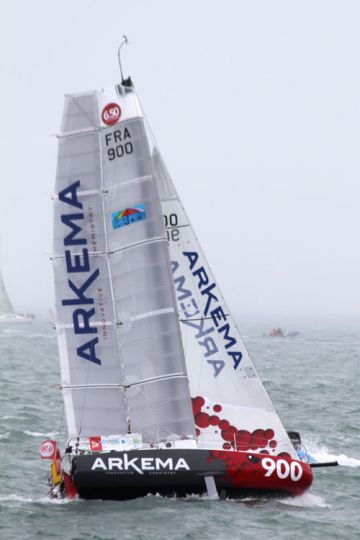
How did this project come about? Is this your idea?
I'm a Lalou Multi employee who manages the partnership with Arkema. I'm really a skipper. Following my Transat in 2015 in Arkema's colors, Lalou Multi offered to build them a new boat. They liked it, the only obligation was to use this resin. After that it was carte blanche. There was the new rule, but the project to make something really innovative: it was an idea from Lalou Multi and Romaric. I would have gone with a boat a little less different from the others, just enough to beat the competition. But once the choices had been made, I adapted myself and did the best I could to make it all work.






